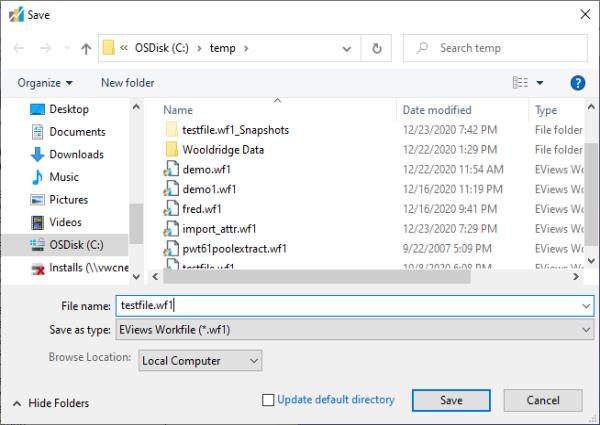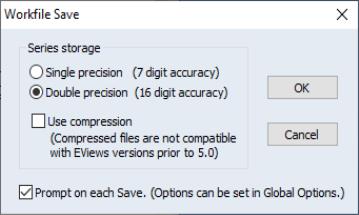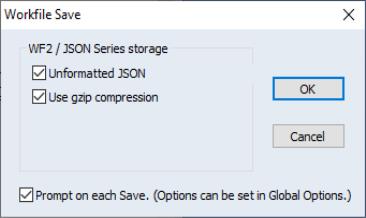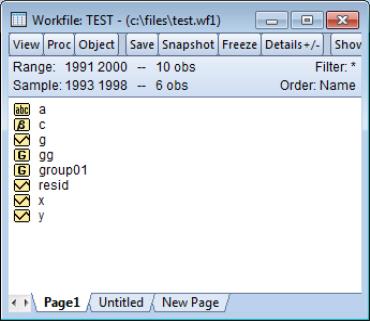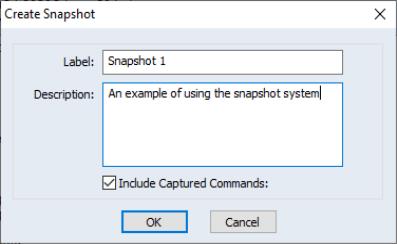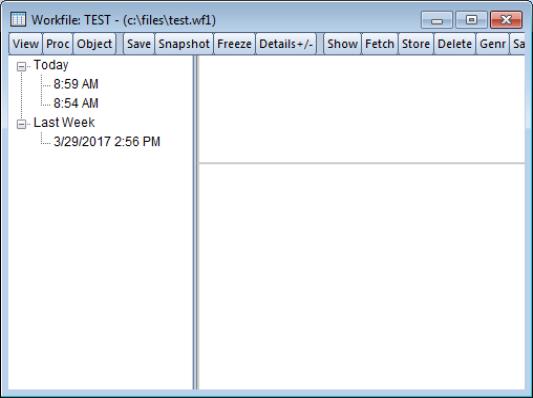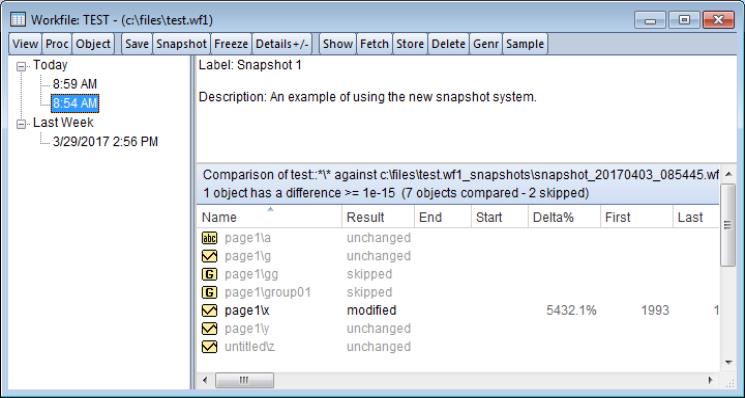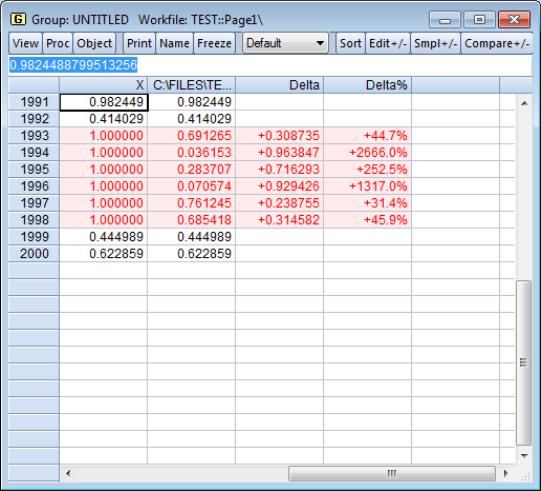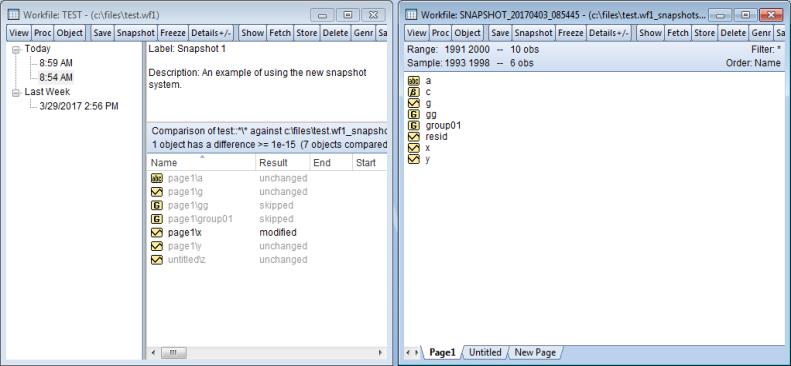Saving a Workfile
You should name and save your workfile for future use. Push the button on the workfile toolbar to save a copy of the workfile on disk. You can also save a file using the or choices from the main menu. EViews will display the Windows common file dialog.
You can specify the target directory in the upper file menu labeled Save in. You can navigate between directories in the standard Windows fashion—click once on the down arrow to access a directory tree; double clicking on a directory name in the display area gives you a list of all the files and subdirectories in that directory. Once you have worked your way to the right directory, type the name you want to give the workfile in the File name field and push the Save button.
Alternatively, you could just type the full Windows path information and name in the File name edit field.
In most cases, you will save your data as an EViews workfile. By default, EViews will save your data in this format, using the specified name and the extension “.WF1”. You may, of course, choose to save the data in your workfile in a foreign data format by selecting a different format in the dropdown menu. We explore the subject of saving foreign formats below in
“Exporting from a Workfile”.
Saving Updated Workfiles
You may save modified or updated versions of your named workfile using the button on the workfile toolbar, or by selecting from the main menu. Selecting will update the existing workfile stored on disk. You may also use to save the workfile with a new name. If the file you save to already exists, EViews will ask you whether you want to update the version on disk.
When you overwrite a workfile on disk, EViews will usually keep a backup copy of the overwritten file. The backup copy will have the same name as the file, but with the first character in the extension changed to ~. For example, if you have a workfile named “Mydata.WF1”, the backup file will be named “Mydata.~f1”. The existence of these backup files will prove useful if you accidentally overwrite or delete the current version of the workfile file, or if the current version becomes damaged.
If you wish to turn on or off the creation of these backup copies you should set the desired global options by selecting , and selecting the desired settings.
Workfile Save Options
By default, when you click on the button, EViews will display a dialog showing the current global default options for storing the data in your workfile.
Your first choice is whether to save your series data in either or . Single precision will create smaller files on disk, but saves the data with fewer digits of accuracy (7 versus 16).
You may also choose to save your data in compressed or non-compressed form. If you select , EViews will analyze the contents of your series, choose an optimal (lossless) storage precision for each series, and will apply compression algorithms, all to reduce the size of the workfile on disk. The storage savings may be considerable, especially for large datasets containing lots of integer and 0, 1 variables. We caution however, that a compressed workfile is not backward compatible, and will not be readable by versions prior to EViews 5.
There is also a checkbox for showing the options dialog on each save operation. By default, the dialog will be displayed every time you save a workfile. Unchecking the option instructs EViews to hide this dialog on subsequent saves. If you later wish to change the save settings or wish to display the dialog on saves, you must update your global settings by selecting from the main EViews menu and going to the portion of the dialog.
Note that, with the exception of compressed workfiles, WF1 workfiles may be read by previous versions of EViews. Objects with features that are not supported by early versions will, however, be dropped when read by those versions of EViews. You should take great caution when saving newer workfiles using older versions of EViews as you will lose any deleted objects).
Note also that only the first page of a multi-page workfile will be read by versions prior to EViews 5; all other pages will be dropped. You may save individual pages of a multi-page workfile to separate workfiles so that they may be read by versions that do not support multiple pages (see
“Saving a Workfile Page”).
If you are saving your workfile in the newer WF2 format, you will be presented with JSON save options. You may choose to whether or not to write in Unformatted JSON format and whether to use GZIP compression. Checking the former will save the workfile in a verbose, human-readable JSON format. Checking the latter will minimize the resulting file size by saving the workfile using compression.
Snapshot Backups
EViews offers a snapshot backup feature. While working with a workfile, or editing an EViews program, the snapshot system will automatically take periodic backups of your changes and save them to a separate snapshot file. To review your changes, you can then bring up the list of available snapshots and compare your current data or program to each snapshot. This allows you to have a history of your changes and potentially restore any previous versions of your data or program before you save your final changes to the original file.
You can also take manual snapshots, such as before revising or editing a large series. A user-defined label and description is provided to help keep track of these changes.
Snapshots for Workfiles
When you have a workfile open in EViews, click the Snapshot button to instruct EViews to save a copy of the workfile at that point in time.
Note: Snapshots will only work for files that have already been saved locally. Unsaved files or files that have been saved to a cloud folder location are excluded from the snapshot system.
In the Create Snapshot dialog, you can specify your own label and description for the snapshot. For workfiles, EViews will also let you include any captured commands that were generated since the last snapshot. All of this information will be saved along with the snapshot.
Viewing Snapshots for Workfiles
To view available snapshots for a workfile, click the View button and switch to the view.
The tree on the left will display all available snapshots with the most recent snapshot at the top. If you click on a snapshot, you can see the metadata and a comparison of objects that have changed between that snapshot’s timestamp and the current time.
In this example, the comparison view shows that the current X object in our workfile is different from the snapshot that was taken today at 8:54am.
Double-clicking the "page1\x" row will display a new group window that shows the exact differences.
Alternatively, you can also right-click the "8:54 AM" node and select (or simply double-click the node) to open the snapshot in its own workfile window.
Now with both workfiles open, you can easily inspect differences and copy over individual observations by hand.
If you would simply like to revert the entire workfile to be the same as the selected snapshot, right-click the snapshot node and select . This will load the snapshot as the current workfile in memory. You must still manually save the workfile to overwrite the previous version of the file.
Note that automatic snapshots are suspended when an EViews program is actively running.
See the
wfsnapshot command for additional information.
